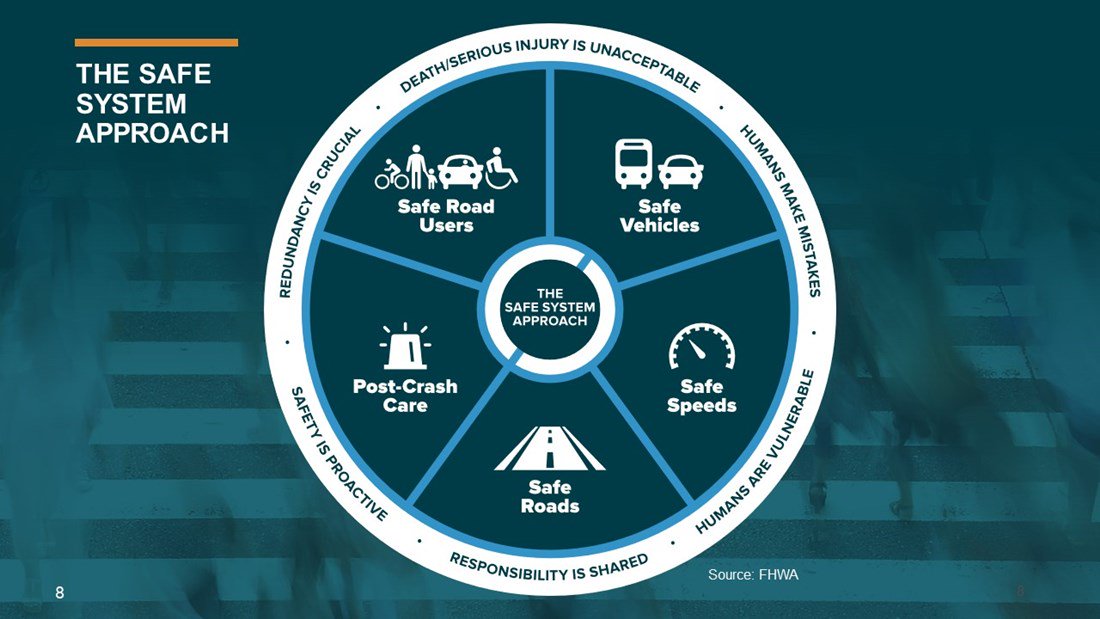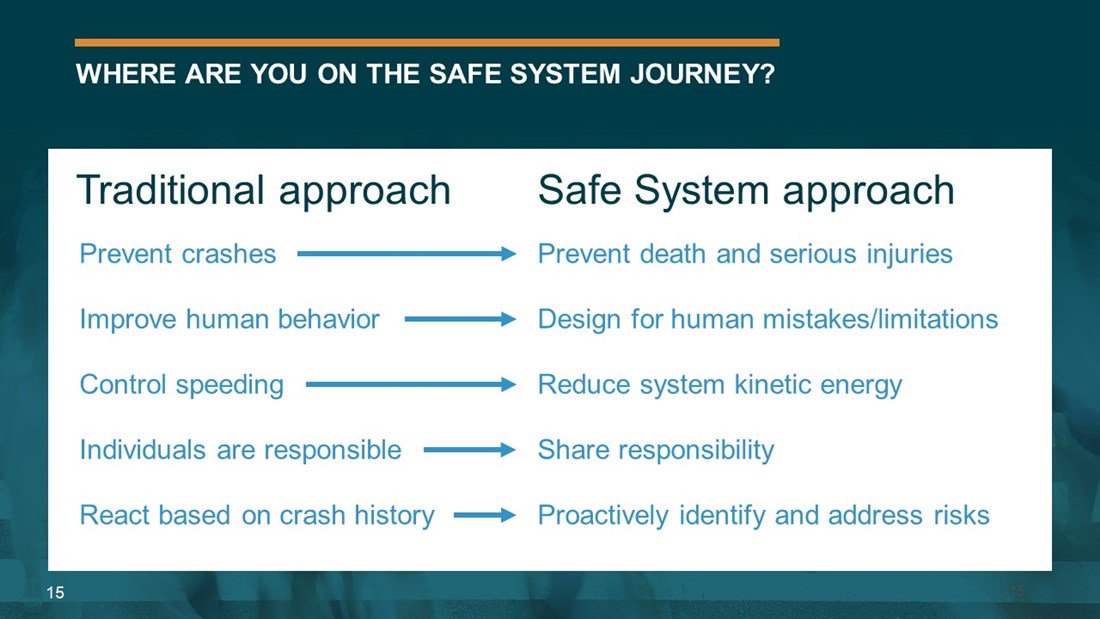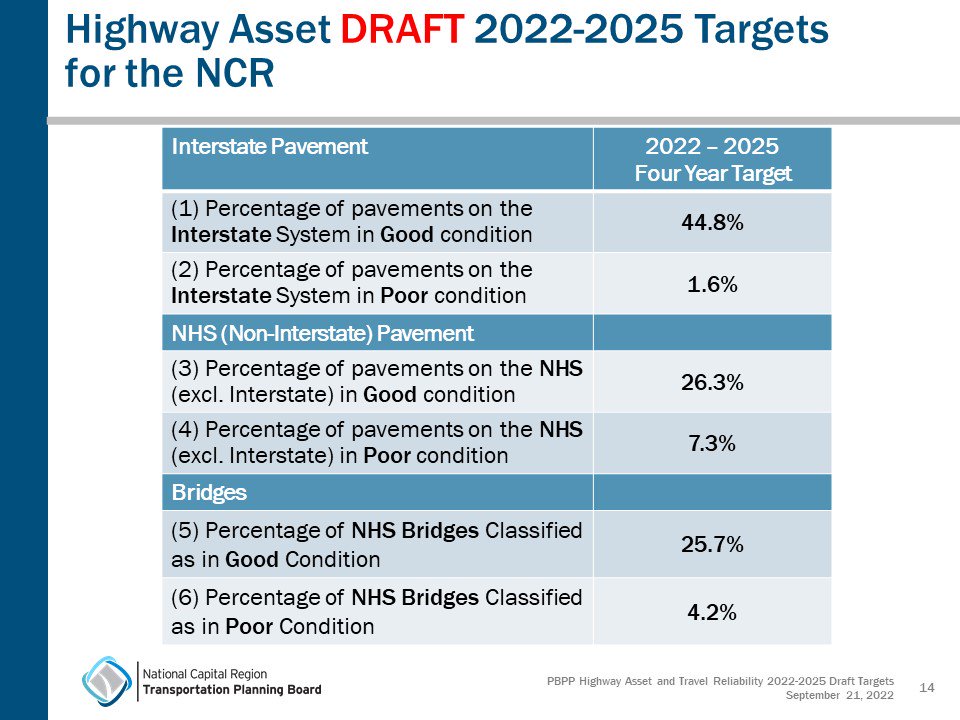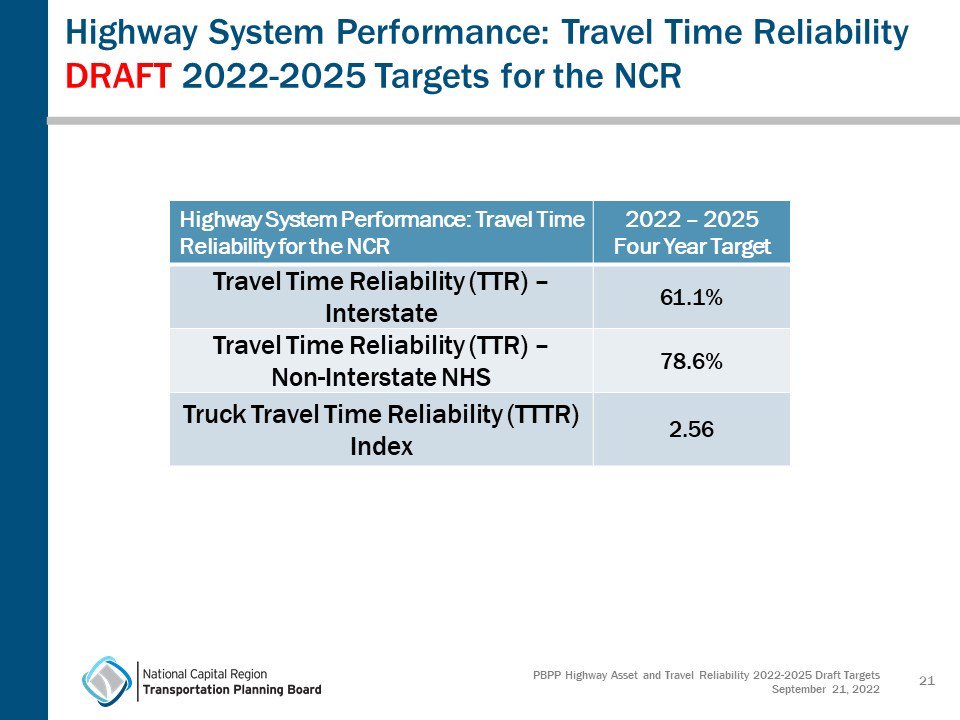At its September meeting, the TPB approved a resolution to update its Bylaws and received a briefing on draft 2022-2025 regional targets for highway systems performance and bridge and pavement highway asset conditions. In addition, the Federal Highway Administration shared an overview of the U.S. DOT’s Safe System Approach.
Meeting agenda, materials, and recording.
ACTION ITEM
TPB Bylaws Update
The TPB approved Resolution R2-2023, updating the TPB Bylaws, which includes a text amendment that places no limits on virtual participation or requirements for in-person participation in TPB meetings. A member wishing to participate virtually shall give at least three days’ notice to the Director or designated staff. For specific details, TPB board and committee members may refer to the updated Bylaws text on the COG/TPB website.
INFORMATIONAL ITEMS
Safe System Approach
Representing a paradigm shift for the U.S. Department of Transportation, the Safe System Approach (SSA) offers a framework to reduce roadway fatalities and serious injuries. David Petrucci, FWHA Senior Safety Engineer, provided an overview of SSA which accommodates human mistakes and keeps impacts to the human body to a tolerable level. Countries that were early adopters of SSA (Sweden, Netherlands, Australia, and New Zealand) experienced at least a 50 decrease in fatalities during the mid-1990s to 2015 period. Petrucci noted that for comparative purposes, the U.S. experienced an approximate 11 percent decrease in fatalities during the same period.
In a traditional approach, there is emphasis on preventing crashes from occurring, improving human behavior, controlling speeding, leaving responsibility up to individuals, and initiatives tend to be reactive based on crash history, as opposed to being proactive.
In a Safe System Approach, key components include six principles and five safe system elements. Infrastructure is designed for human mistakes and shared responsibility is emphasized. Education, enforcement, emergency response, and engineering are refocused not abandoned under SSA.
FHWA emphasized that there is no one path to implement the Safe System Approach; it is a multi-pronged process of implementation across programs and infrastructure that is guided by the underlying principles and takes local context into account.
ITE Resources: https://www.ite.org/technical-resources/topics/safe-systems
Patrick Wojahn, College Park City Council Mayor, asked how off-road infrastructure for bicycling and walking fits into the safe system approach. Petrucci said the off-roadway environment in which users are operating and making decisions is included. “We are talking about the physical infrastructure that exists to support multiple user types and modes of travel. We are talking about the environment in which users -- all users -- are operating.” Petrucci also noted that management of potential conflicts, including those involving access and development, is also part of SSA considerations.


Source: FHWA
Draft 2022-2025 Regional Targets for Highway Systems Performance
Eric Randall, TPB Transportation Engineer, shared proposed 2022-2025 regional targets for Highway Asset (Pavement and Bridge Condition) measures and for Highway Systems Performance: Travel Time Reliability. Target setting is part of the TPB’s federal required performance-based planning and programming (PBPP). State DOTs must develop as well as formally adopt new 2022 – 2025 targets and submit the targets to FHWA by October 1, 2022. TPB, as an MPO, coordinates with the District DOT, Maryland DOT, and Virginia DOT to set its own targets which TPB board members will be asked to approve on October 19. Approved targets will be included in a revised Visualize 2045 Long-Range Transportation Plan System Performance Report.
What is measured?
Highway Assets: Percent of Interstate, National Highway System (non-Interstate), and bridges classified in good or poor condition
Travel Time Reliability (TTR): Percent of person-miles traveled on the Interstate System and Non-Interstate National Highway System that are reliable
Truck Travel Time Reliability (TTTR): Ratio of the Interstate System Mileage providing for Reliable Truck Travel Times
Randall noted that approximately 10 percent of the region’s funding will be put toward keeping highway assets in good condition. In general, the state DOTs are planning for slowly degrading asset conditions. There's an increased focus on the non-interstate National Highway System (NHS) and on other state-maintained roads. Randall reported that Virginia DOT, for example, maintains many non-NHS routes that will be a focus for resources.
The draft target tables are posted below. More information is available on the TPB meeting page or on TPB’s Performance Based Planning and Programming page.


Source: TPB
Committee and Director’s Reports
TPB Technical Committee, Access for All Committee, Community Advisory Committee and Director’s reports are available on the September 21 TPB Meeting page.
TPB Technical Committee
Chair Matt Arcieri reported that the Technical Committee agenda included information on the Visualize 2045 update and the National Performance Management Measures; Assessing Performance of the National Highway System, Greenhouse Gas Emissions Measure Notice of Proposed Rulemaking (NPRM) to add a Greenhouse Gas (GHG) performance measure and target-setting requirement, which would require state DOTs and metropolitan planning organizations (MPOs) that have National Highway System (NHS) mileage within their state’s geographic boundaries and metropolitan planning area boundaries to establish declining carbon dioxide (CO2) emissions generated by on-road mobile sources relative to a reference year defined as calendar year 2021. The NPRM deadline for comments is October 13.
In response to the NPRM, TPB staff will submit a letter to the U.S. DOT docket stating that the TPB supports establishing targets. Specific comments that the TPB proposes are summarized here:
- The TPB recommends against reporting of the proposed GHG performance measures for the Urbanized Area (UZA) and strongly endorses using the metropolitan planning area as the area of measurement and target-setting. The UZA does not align with jurisdictional boundaries, which, in most places, is where preliminary transportation project planning and programming decisions are made.
- The TPB appreciates the additional flexibility afforded to MPOs, as compared to state DOTs, to measure performance and establish targets following their own processes as described in the proposed rule. The TPB encourages the U.S. DOT to extend this flexibility to the option to develop the GHG performance measure for all public roads, rather than being limited to roads in the NHS.
- The TPB supports a longer period for states to submit targets than the October 2022 date included in the proposed rule due to the time it takes for state DOT, MPO, and stakeholder collaboration. The TPB suggests a deadline of six to nine months after the rule is finalized as more appropriate.
- The TPB notes that additional resources may be needed for measuring GHG emissions performance each year.
TPB Community Advisory Committee
Chair Ashely Huston reported that the September 15 Community Advisory Committee (CAC) meeting included discussions with state DOT representatives: Sam Brooks, District DOT, Kari Snyder, Maryland DOT, and Amir Shahpar from Virginia DOT. The state DOT representatives spoke on coordination with the TPB and the MPO process. During the breakouts, CAC members and the DOTs talked about effective public engagement, project and long-range planning engagement, and the effectiveness of public comment organized at a community level.
TPB Access for All Advisory Committee
Chair Canek Aguirre shared that committee members learned about the National Capital Planning Commission’s Pennsylvania Avenue NW Initiative at their September meeting. AFA committee members provided input on existing conditions, impacts on persons with disabilities, and accessibility considerations. The AFA also received updates on Equity Emphasis Areas, how EEAs are used as a planning resource by jurisdictions in the region, and the status of bicycle and pedestrian planning for the National Capital Region.
Director’s Report
Kanti Srikanth, TPB Staff Director, shared the following announcements:
Visualize 2045 and FY 2023-2026 Conformity Approval
In August 2022, The TPB received joint Federal Highway Administration and Federal Transit Administration approval and determination, and Environmental Protection Agency concurrence, of air quality conformity of the Visualize 2045 long-range transportation plan update and the FY 2023-FY 2026 Transportation Improvement Program (TIP). At a future TPB meeting, staff will present a schedule for the 2024 update to the region’s long-range transportation plan and FY 2025- FY 2028 TIP.
COG electric vehicle (EV) deployment clearinghouse and EV deployment working group
The COG Board recently adopted a resolution establishing an EV working group under COG’s Climate, Energy, and Environment Policy Committee (CEEPC) that will bring together jurisdictional representatives and other public and private sector partners. The group is an opportunity to coordinate actions at the regional level and prioritize EV-related information sharing, developing templates for policies and practices, regional partnerships, and identifying opportunities for funding support. The clearinghouse will provide information on local EV planning, zoning, permitting, and incentive policies, as well as charging station procurements and installation/operation support agreements.
District of Columbia Transportation Alternatives Set-Aside Program accepting applications
The application period for DDOT’s TA Set-Aside Program is now open. The application deadline is November 1. The TA Set-Aside is a federal program that funds smaller-scale capital improvement projects such as pedestrian and bicycle facilities, trails, safe routes to school (SRTS) projects, environmental mitigation, and other community improvements.
Car Free Day 2022
More than 4,000 commuters and residents in the metropolitan Washington region took the pledge to go car free or car-lite on this year’s September 22 Car Free Day. Car Free Day is celebrated to help the region reduce traffic congestion, decrease GHG emissions, and help residents embrace a healthy lifestyle through carpooling, walking, bicycling, taking transit, or teleworking.
Note: The 2022 State of the Commute Survey report scheduled for the September TPB meeting will be presented at a future meeting.
NEXT MEETING
The next TPB meeting is scheduled for October 19 at 12:00 P.M. A YouTube livestream option will be available.